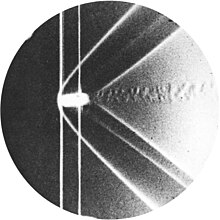Talk:Oblique shock
Robert T | @ | C 01:48, 19 November 2005 (UTC)
this matherial is better than in shock wave
I am attempting to provide some figures and to explain this physical phenomena in simple terms. genick bar-meir
this orinal matherial which not appear in shock wave
Shock wave a side to fact that it contain banch of nonsense has only reference to oblique shock. In fact, the term shock wave should be broken into several terms like moving shock waves, shock wave with chemical reactions etc. Have only reference to NASA Glenn Research Center information on: Oblique Shocks is not enough.
Yet, there is a need for several drawing and experimental pictures. —The preceding unsigned comment was added by Genick (talk • contribs) 11:28, 29 December 2006 (UTC).
Reasons for adding various templates
Oblique shocks are important gas dynamics phenomenon and are covered in all undergrad level gas dynamics courses. All the references mentioned in the gas dynamics article has a separate chapter on this topic. However none of those references mention the results (i.e. Bar-Meir's solution) discussed here. There are reasons to believe that the results mentioned here are not according to WP:NOR guidelines.
- No reputable references are provided to support the results presented in the article.
- The link to naca 1135 report is/may not be accessible to general public (esp. non-US citizens).
The article can be further expanded and is an important link between normal shocks and expansion fans. As such it needs attention of an expert in this subject. -Myth (Talk) 11:32, 4 February 2007 (UTC)
Mach's picture of a bullet
The article now says The first to discover this shock was Ernst Mach in his original picture showing a bullet in a supersonic flow that cause the oblique shock.
Is this talking about this picture?

I think this is a picture of a bullet fired into stationary air, while the sentence above seems to say that it's being fired into air that was already moving at supersonic speeds. I suggest discussing this at Talk:shock wave#Mach's picture of a bullet since there is already discussion there, although I suspect a change in wording in this article is required. --Coppertwig 02:07, 7 February 2007 (UTC)
the bullet
This bullet was not fired. This bullet was attached into arm and was rotated. It moveed into air with known speed. Is this clarify this point.
potto 15:33, 20 April 2007 (UTC) genick
- Is it an important difference whether the bullet was fired from a weapon, or an "acceleration device"?AKAF 16:04, 20 April 2007 (UTC)
New Oblique Shock Page
The previous oblique shock information was terrible, so I deleted it and will finish a new page soon. I have already divided the page into some sections that I will expand upon. EMBaero 19:46, 26 July 2007 (UTC)EMBaero
New Oblique Shock Page
Someone remove all the equations that I inserted to this article. Why to insert so many mistakes. First, Oblique shock has three solutions and not two. Second, when there is detached shock (why remove this term?) it is a normal shock and not curved shock. Why one remove the the equations showing the solution? --potto 14:47, 17 October 2007 (UTC)
